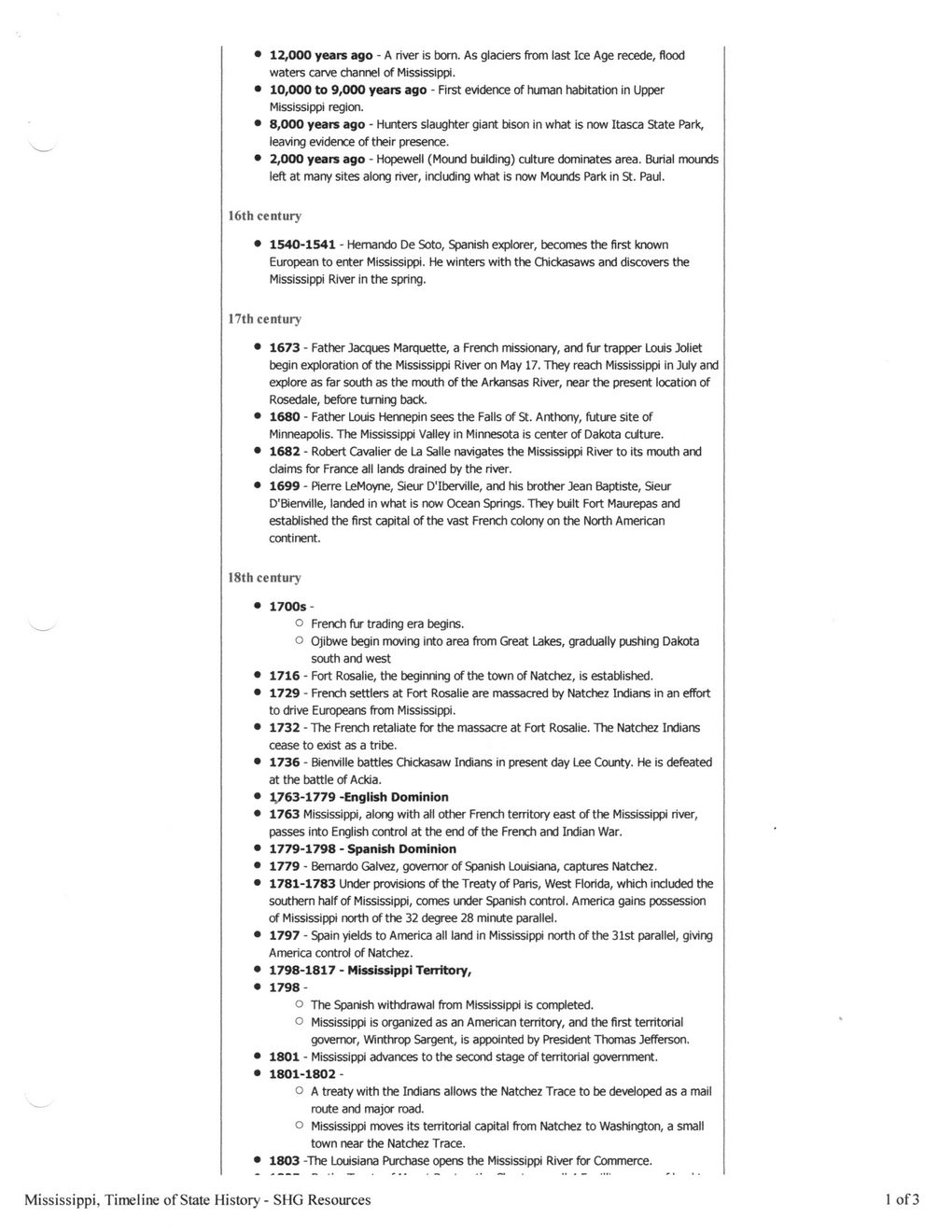This text was obtained via automated optical character recognition.
It has not been edited and may therefore contain several errors.
• 12,000 years ago - A river is bom. As glaciers from last Ice Age recede, flood waters carve channel of Mississippi. • 10,000 to 9,000 years ago - First evidence of human habitation in Upper Mississippi region. • 8,000 years ago - Hunters slaughter giant bison in what is now Itasca State Park, leaving evidence of their presence. • 2,000 years ago - Hopewell (Mound building) culture dominates area. Burial mounds left at many sites along river, including what is now Mounds Park in St. Paul. 16th century • 1540-1541 - Hernando De Soto, Spanish explorer, becomes the first known European to enter Mississippi. He winters with the Chickasaws and discovers the Mississippi River in the spring. 17th century • 1673 - Father Jacques Marquette, a French missionary, and fur trapper Louis Joliet begin exploration of the Mississippi River on May 17. They reach Mississippi in July and explore as far south as the mouth of the Arkansas River, near the present location of Rosedale, before turning back. • 1680 - Father Louis Hennepin sees the Falls of St. Anthony, future site of Minneapolis. The Mississippi Valley in Minnesota is center of Dakota culture. • 1682 - Robert Cavalier de La Salle navigates the Mississippi River to its mouth and claims for France all lands drained by the river. • 1699 - Pierre LeMoyne, Sieur D'Iberville, and his brother Jean Baptiste, Sieur D'Bienville, landed in what is now Ocean Springs. They built Fort Maurepas and established the first capital of the vast French colony on the North American continent. 18th century • 1700s- o French fur trading era begins. o Ojibwe begin moving into area from Great Lakes, gradually pushing Dakota south and west • 1716 - Fort Rosalie, the beginning of the town of Natchez, is established. • 1729 - French settlers at Fort Rosalie are massacred by Natchez Indians in an effort to drive Europeans from Mississippi. • 1732 - The French retaliate for the massacre at Fort Rosalie. The Natchez Indians cease to exist as a tribe. • 1736 - Bienville battles Chickasaw Indians in present day Lee County. He is defeated at the battle of Adda. • lk763-1779 -English Dominion • 1763 Mississippi, along with all other French territory east of the Mississippi river, passes into English control at the end of the French and Indian War. • 1779-1798 - Spanish Dominion • 1779 - Bernardo Galvez, governor of Spanish Louisiana, captures Natchez. • 1781-1783 Under provisions of the Treaty of Paris, West Florida, which inducted the southern half of Mississippi, comes under Spanish control. America gains possession of Mississippi north of the 32 degree 28 minute parallel. • 1797 - Spain yields to America all land in Mississippi north of the 31st parallel, giving America control of Natchez. • 1798-1817 - Mississippi Territory, • 1798- o The Spanish withdrawal from Mississippi is completed. o Mississippi is organized as an American territory, and the first territorial governor, Winthrop Sargent, is appointed by President Thomas Jefferson. • 1801 - Mississippi advances to the second stage of territorial government. • 1801-1802- O A treaty with the Indians allows the Natchez Trace to be developed as a mail route and major road. o Mississippi moves its territorial capital from Natchez to Washington, a small town near the Natchez Trace. • 1803 -The Louisiana Purchase opens the Mississippi River for Commerce. Mississippi, Timeline of State History - SHG Resources 1 of 3

Mississippi General Document (001)